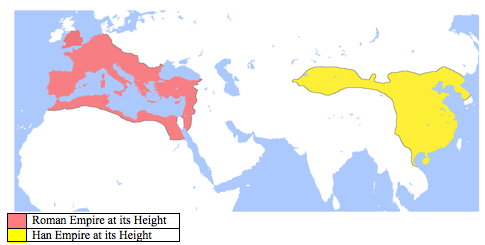
Unit 1: Redefining World Society and Culture
Lesson C: Rise and Fall of the Classical and Medieval World
Lesson Overview
Empires rise and fall. Throughout history, different empires have controlled different parts of the world. These empires normally gained power through a superior army and powerful rulers. Early empires, such as the Roman Empire and Han Empire, established the concept of what is meant by an "empire." Empires control large areas of land and institute their own system of political control. At its height, the Roman Empire controlled most of Europe and the Mediterranean world and the Han Empire controlled large parts of East Asia. As time went on, these empires declined and were replaced by other empires. Many empires, such as the Mongol and various Islamic empires, ruled over diverse populations, but they created systems to rule efficiently over these large and diverse empires.

The Roman Empire and Han Empire at Their Heights [1]
Key Questions
- How and why do empires emerge?
- How and why do empires fall?
- How were Islamic empires able to rule effectively over diverse empires?
- How do I analyze and understand secondary sources?
Student Outcomes
- Compare the rise of empires such as the Aztecs and Incas in the Americas, the Gupta in India, the Sudanic states in Africa, the Byzantine in Europe, and the Tang and Song in China.
- Analyze Arab Muslim success in founding an empire stretching from Western Europe to India and China and describe the diverse religious, cultural, and geographic factors that influenced the ability of the Muslim government to rule.
- Compare the concept of empire building, found within the Islamic empires in Western Europe, India, and China with the Mongol empires of China, Southeast Asia, Russia, and Southwest Asia, including the effects on diverse cultures within these empires.
- Analyze various causes that historians have proposed to account for the decline of empires, such as the Roman, Han, Mauryan, and Mayan empires.
- Draw comparisons across eras and regions in order to define enduring issues, as well as large-scale or long-term developments that transcend regional and temporal boundaries. (Historical Thinking Skill)
Key Terms
Student Resources
- Rise of Empires Presentation Graphic Organizer (doc)
- Historical Investigation — Cultural Diversity in the Islamic Empires (doc)
- Examining Secondary Sources (doc)
- Rise and Fall of Empires — Brief Constructed Response (BCR) (doc)
Chart of Activities
| Activities to Complete | Estimated Time |
|---|---|
| Pre-Assessment | 5 minutes |
| Key Terms | 5 minutes |
| Activator: The World - Ancient to 1300s | 5 minutes |
| Opening: Classical and Medieval Empires | 15 minutes |
| Activity 1: Understanding the Concept and Foundation of Empires | 15 minutes |
| Activity 2: Rise of Empires | 30 minutes |
| Activity 3: Secondary Sources | 10 minutes |
| Activity 4: Check for Understanding – Types of Sources | 10 minutes |
| Activity 5: Examining Secondary Sources | 10 minutes |
| Activity 6: Diversity in the Islamic Empire | 20 minutes |
| Activity 7: Islamic Empires Assessment | 5 minutes |
| Activity 8: The Mighty Will Fall | 20 minutes |
| Review and Assessment | 20 minutes |
| Lesson Summary | 5 minutes |
Lesson Completion Time
The total estimated time to complete this lesson is 175 minutes.
Page Notes:
[1] Source: This image from http://commons.wikimedia.org/wiki/File:RomanandHanEmpiresAD1.png has been modified and is licensed with Creative Commons Attribution. Attribution: Gabagol.

